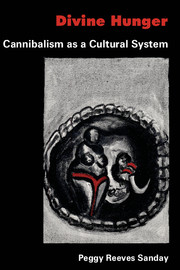Book contents
- Frontmatter
- Contents
- Preface
- Acknowledgments
- Introduction
- The symbols that give rise to a cannibalistic consciousness
- 3 The mysteries of the body: Hua and Gimi mortuary cannibalism
- 4 The androgynous first being: Bimin-Kuskusmin cannibalism
- 5 Cannibal monsters and animal friends
- The mythical chartering and transformation of cannibal practice
- Notes
- References
- Index
3 - The mysteries of the body: Hua and Gimi mortuary cannibalism
Published online by Cambridge University Press: 05 June 2012
- Frontmatter
- Contents
- Preface
- Acknowledgments
- Introduction
- The symbols that give rise to a cannibalistic consciousness
- 3 The mysteries of the body: Hua and Gimi mortuary cannibalism
- 4 The androgynous first being: Bimin-Kuskusmin cannibalism
- 5 Cannibal monsters and animal friends
- The mythical chartering and transformation of cannibal practice
- Notes
- References
- Index
Summary
The inside of the body is the temple, the place where the awesome powers reside; internal body states are imagined in intense detail. … Any body is awesome, but the female body, possessor of the mystery of fertility and nurture, is the most awesome. In this religion of the body the female body plays the star role.
The logic of Hua mortuary cannibalism is the main subject of this chapter. This logic provides the basis for my analysis of Gimi mortuary cannibalism and Melpa mortuary practices in which pig flesh is substituted for human flesh. These examples establish the relevance of maternal and intrauterine imagery for comprehending the meaning of cannibal practice. I suggest that the primordial pull of the maternal, the unitary symbol from which all opposites emanate, establishes the moods and motivations that make Hua and Gimi cannibalism inevitable. For both groups, cannibalism is part of a system of symbols by means of which individual and social identity are defined and biological and social reproduction ensured.
The concerns evident in Hua ontology may be tied to protein deficiency and the delayed rates of growth, relative to females, that this deficiency produces in males. The indivisibility of mother and child is also evident in Gimi ontology; however, male control of pig flesh extricates men from the cycle of cannibalism displayed by women alone.
- Type
- Chapter
- Information
- Divine HungerCannibalism as a Cultural System, pp. 59 - 82Publisher: Cambridge University PressPrint publication year: 1986



